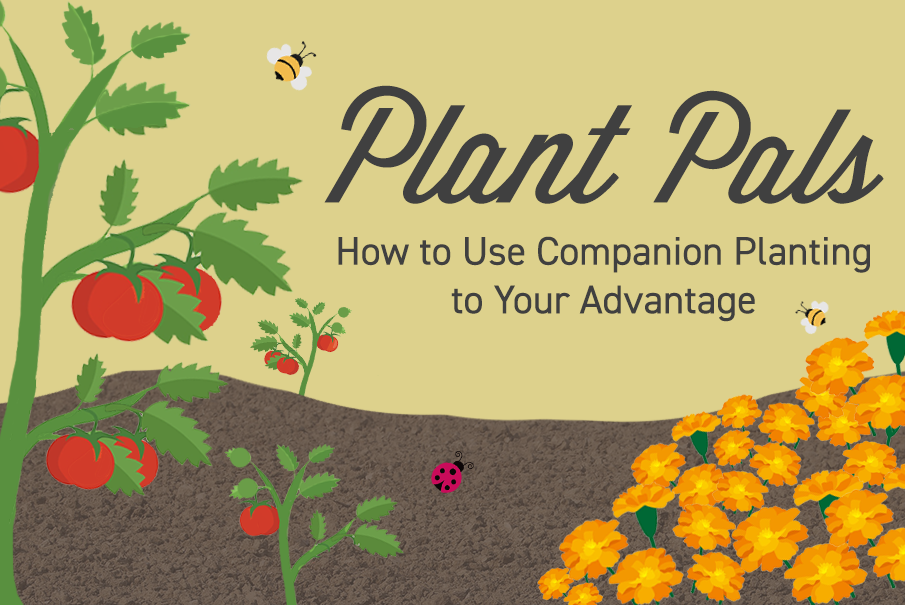How to use companion planting to your advantage

Did you know that in the same way certain zodiac signs are thought to make good matches with other signs, the same can be said for plant types? Well, just as Capricorns are thought to pair well with Scorpios, some vegetables are proven to benefit from being grown alongside other plants.
Known as companion planting, certain planting arrangements can lead to an abundance of benefits - from pollination right through to pest control. Here is our handy guide on what to plant where - and we’ll even share some of the science behind it.
Are You Planting…

Carrots, tomatoes, brassicas or alliums
Deter flea beetles by placing a pot of mint nearby. You’ll want to keep it in a pot or your mint will get greedy and take over the plot.
Carrots and leeks
Wave goodbye to aphids and invite the local pollinators by planting lavender. This strongly scented flower does wonders for protecting carrots and leeks.

Tomatoes and beans
Pop some cheerful calendulas or marigolds alongside your tomato and bean beds to tempt beneficial predatory bugs to rid you of whitefly and aphids. These flowers create a perfume which bugs typically hate, so you’ll have a better chance of keeping them at bay.
Runner beans
Nasturtiums are sweet, dainty little flowers which also happen to be a perfect sacrifice in place of your crops. They’re extremely desirable to aphids, so those pesky critters will feast on the flower heads before they even consider your crops. Bonus points? Nasturtiums are edible for people too! They have a spicy, peppery flavour which can be used as a tasty addition to a salad or as a decorative element on a dish. The flowers can be eaten at any stage but the leaves are best when freshly grown.

Any crop - but especially strawberries
Borage isn’t just a pretty flower - it’s also a fantastic magnet to pollinating insects such as solitary bees, which will devour pests such as hornworm which feast off strawberries. When placed nearby your crops, these flowers can increase how many pollinators come to your neck of the woods, which with any luck, should mean a larger harvest!
If your strawberries are typically attacked by hornworm, borage will be your knight in shining armour. It’s also known for improving the flavours of the fruit too.
Cucumbers
If a flower and a vegetable could be friends, cucumber and nasturtiums would be besties. Beyond their similar sprawling and low growing approaches, nasturtium has also been noted for its ability to repel all the bugs which love to munch on cucumbers. A match made in heaven.
Vegetable Combinations

Lettuce & Tomatoes or Aubergines
This is a great example of a ying and yang balance in gardening. Lettuce struggles with the heat, whilst both tomatoes and aubergines thrive in it. Thanks to the height which tomatoes and eggplants typically reach, they can offer shade to their lettuce pals, which could even extend your lettuce harvest season.
Tomatoes & Cabbage
The beauty of tomatoes (beyond their tasty goodness) is their talent for fending off diamondback moth larvae, which are well known for the large holes they like to create in cabbage leaves.
Radishes & Spinach
If you’re tired of leaf miners doing you dirty when it comes to your healthy greens, a clever attack would be to involve some radishes. The leaf miners will head for the radish leaves over the spinach - and fear not, the radish will continue to grow happily underground, even if its leaves are taking a bashing. Of course, every plant can only take so much, so improve your radishes chances by keeping the soil moist, grow your plants under fleece and provide a nitrogen-rich fertiliser for a happy harvest.
The Three Sisters Approach
This centuries old approach of growing corn, beans and squash alongside one another is successful for three reasons. The corn provides support for the growing beans, the beans fix nitrogen into the soil (which is ideal for a hearty harvest) and finally, the squash SQUASHES weeds by providing ground cover. Now that is teamwork.
Why does companion planting work?
Summed up in one word - diversity. This tried and tested approach supports the idea that we can all achieve more when we all have different roles to play. Whilst observations on this method have been made over centuries, scientists are still studying how diversity impacts agriculture. Our suggestion? Get creative with your planting plans, you might surprise yourself.
Have you attempted companion planting before? Would you? Let us know in the comments!
If you’re at a loss of what to grow next, find Nutley’s seeds here. We also stock a wide selection of pest control products here.
If you liked this article, why not have a read of our seed saving blog?